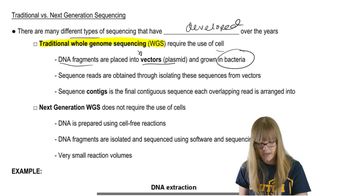Table of contents
- 1. Introduction to Genetics51m
- 2. Mendel's Laws of Inheritance3h 37m
- 3. Extensions to Mendelian Inheritance2h 41m
- 4. Genetic Mapping and Linkage2h 28m
- 5. Genetics of Bacteria and Viruses1h 21m
- 6. Chromosomal Variation1h 48m
- 7. DNA and Chromosome Structure56m
- 8. DNA Replication1h 10m
- 9. Mitosis and Meiosis1h 34m
- 10. Transcription1h 0m
- 11. Translation58m
- 12. Gene Regulation in Prokaryotes1h 19m
- 13. Gene Regulation in Eukaryotes44m
- 14. Genetic Control of Development44m
- 15. Genomes and Genomics1h 50m
- 16. Transposable Elements47m
- 17. Mutation, Repair, and Recombination1h 6m
- 18. Molecular Genetic Tools19m
- 19. Cancer Genetics29m
- 20. Quantitative Genetics1h 26m
- 21. Population Genetics50m
- 22. Evolutionary Genetics29m
15. Genomes and Genomics
Sequencing the Genome
Problem 4b
Textbook Question
Compare and contrast WGS to a map-based cloning approach.
 Verified step by step guidance
Verified step by step guidance1
Step 1: Define Whole Genome Sequencing (WGS) and map-based cloning. WGS involves sequencing the entire genome in one go, providing a comprehensive view of the genetic material. Map-based cloning, on the other hand, involves identifying and isolating a gene of interest by first creating a genetic map and then using this map to locate the gene.
Step 2: Discuss the process of WGS. In WGS, the genome is fragmented into smaller pieces, which are then sequenced. The sequences are assembled using computational methods to reconstruct the entire genome. This approach is fast and provides a high-resolution view of the genome.
Step 3: Explain the process of map-based cloning. This approach starts with the identification of a phenotype linked to a genetic marker. Researchers create a genetic map using these markers and then narrow down the location of the gene of interest through successive rounds of mapping and cloning.
Step 4: Compare the advantages of WGS and map-based cloning. WGS is advantageous for its speed and ability to provide a complete genome sequence, which is useful for identifying multiple genes and variations. Map-based cloning is more targeted, allowing for precise identification of a specific gene associated with a phenotype.
Step 5: Contrast the limitations of WGS and map-based cloning. WGS can be computationally intensive and may generate large amounts of data that require significant analysis. Map-based cloning can be time-consuming and labor-intensive, as it requires the construction of a genetic map and multiple rounds of experimentation to isolate the gene.
Recommended similar problem, with video answer:
 Verified Solution
Verified SolutionThis video solution was recommended by our tutors as helpful for the problem above
Video duration:
2mPlay a video:
Was this helpful?
Key Concepts
Here are the essential concepts you must grasp in order to answer the question correctly.
Whole Genome Sequencing (WGS)
Whole Genome Sequencing (WGS) is a comprehensive method used to determine the complete DNA sequence of an organism's genome. This technique allows researchers to analyze all genetic variations across the entire genome, providing insights into genetic diversity, disease susceptibility, and evolutionary relationships. WGS is particularly powerful for identifying mutations and understanding complex traits, as it captures both coding and non-coding regions of DNA.
Recommended video:
Guided course

Sequencing Overview
Map-Based Cloning
Map-based cloning is a genetic mapping technique used to identify and isolate specific genes associated with traits of interest. This approach involves creating a genetic map of the organism, which helps in locating the gene of interest by analyzing recombination events and using molecular markers. It is particularly useful for studying complex traits in organisms where the genome is not fully sequenced, allowing researchers to focus on specific regions of interest.
Recommended video:
Guided course

Positional Cloning
Comparative Analysis
Comparative analysis between WGS and map-based cloning highlights their distinct methodologies and applications. WGS provides a holistic view of the genome, making it suitable for discovering novel genes and variants, while map-based cloning is more targeted, focusing on specific traits and genes. Understanding these differences is crucial for selecting the appropriate approach based on research goals, available resources, and the complexity of the traits being studied.
Recommended video:
Guided course

Chi Square Analysis

 8:55m
8:55mWatch next
Master Sequencing Overview with a bite sized video explanation from Kylia Goodner
Start learning



